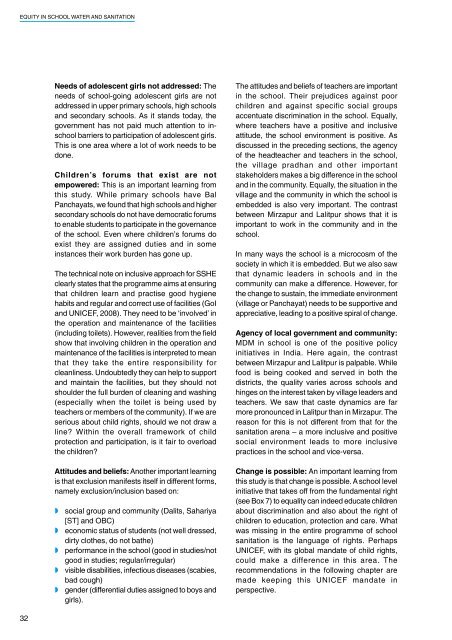Equity in School Water and Sanitation
Equity in School Water and Sanitation
Equity in School Water and Sanitation
You also want an ePaper? Increase the reach of your titles
YUMPU automatically turns print PDFs into web optimized ePapers that Google loves.
EQUITY IN SCHOOL WATER AND SANITATIONNeeds of adolescent girls not addressed: Theneeds of school-go<strong>in</strong>g adolescent girls are notaddressed <strong>in</strong> upper primary schools, high schools<strong>and</strong> secondary schools. As it st<strong>and</strong>s today, thegovernment has not paid much attention to <strong>in</strong>schoolbarriers to participation of adolescent girls.This is one area where a lot of work needs to bedone.Children’s forums that exist are notempowered: This is an important learn<strong>in</strong>g fromthis study. While primary schools have BalPanchayats, we found that high schools <strong>and</strong> highersecondary schools do not have democratic forumsto enable students to participate <strong>in</strong> the governanceof the school. Even where children’s forums doexist they are assigned duties <strong>and</strong> <strong>in</strong> some<strong>in</strong>stances their work burden has gone up.The technical note on <strong>in</strong>clusive approach for SSHEclearly states that the programme aims at ensur<strong>in</strong>gthat children learn <strong>and</strong> practise good hygienehabits <strong>and</strong> regular <strong>and</strong> correct use of facilities (GoI<strong>and</strong> UNICEF, 2008). They need to be ‘<strong>in</strong>volved’ <strong>in</strong>the operation <strong>and</strong> ma<strong>in</strong>tenance of the facilities(<strong>in</strong>clud<strong>in</strong>g toilets). However, realities from the fieldshow that <strong>in</strong>volv<strong>in</strong>g children <strong>in</strong> the operation <strong>and</strong>ma<strong>in</strong>tenance of the facilities is <strong>in</strong>terpreted to meanthat they take the entire responsibility forcleanl<strong>in</strong>ess. Undoubtedly they can help to support<strong>and</strong> ma<strong>in</strong>ta<strong>in</strong> the facilities, but they should notshoulder the full burden of clean<strong>in</strong>g <strong>and</strong> wash<strong>in</strong>g(especially when the toilet is be<strong>in</strong>g used byteachers or members of the community). If we areserious about child rights, should we not draw al<strong>in</strong>e? With<strong>in</strong> the overall framework of childprotection <strong>and</strong> participation, is it fair to overloadthe children?Attitudes <strong>and</strong> beliefs: Another important learn<strong>in</strong>gis that exclusion manifests itself <strong>in</strong> different forms,namely exclusion/<strong>in</strong>clusion based on: social group <strong>and</strong> community (Dalits, Sahariya[ST] <strong>and</strong> OBC) economic status of students (not well dressed,dirty clothes, do not bathe) performance <strong>in</strong> the school (good <strong>in</strong> studies/notgood <strong>in</strong> studies; regular/irregular) visible disabilities, <strong>in</strong>fectious diseases (scabies,bad cough) gender (differential duties assigned to boys <strong>and</strong>girls).The attitudes <strong>and</strong> beliefs of teachers are important<strong>in</strong> the school. Their prejudices aga<strong>in</strong>st poorchildren <strong>and</strong> aga<strong>in</strong>st specific social groupsaccentuate discrim<strong>in</strong>ation <strong>in</strong> the school. Equally,where teachers have a positive <strong>and</strong> <strong>in</strong>clusiveattitude, the school environment is positive. Asdiscussed <strong>in</strong> the preced<strong>in</strong>g sections, the agencyof the headteacher <strong>and</strong> teachers <strong>in</strong> the school,the village pradhan <strong>and</strong> other importantstakeholders makes a big difference <strong>in</strong> the school<strong>and</strong> <strong>in</strong> the community. Equally, the situation <strong>in</strong> thevillage <strong>and</strong> the community <strong>in</strong> which the school isembedded is also very important. The contrastbetween Mirzapur <strong>and</strong> Lalitpur shows that it isimportant to work <strong>in</strong> the community <strong>and</strong> <strong>in</strong> theschool.In many ways the school is a microcosm of thesociety <strong>in</strong> which it is embedded. But we also sawthat dynamic leaders <strong>in</strong> schools <strong>and</strong> <strong>in</strong> thecommunity can make a difference. However, forthe change to susta<strong>in</strong>, the immediate environment(village or Panchayat) needs to be supportive <strong>and</strong>appreciative, lead<strong>in</strong>g to a positive spiral of change.Agency of local government <strong>and</strong> community:MDM <strong>in</strong> school is one of the positive policy<strong>in</strong>itiatives <strong>in</strong> India. Here aga<strong>in</strong>, the contrastbetween Mirzapur <strong>and</strong> Lalitpur is palpable. Whilefood is be<strong>in</strong>g cooked <strong>and</strong> served <strong>in</strong> both thedistricts, the quality varies across schools <strong>and</strong>h<strong>in</strong>ges on the <strong>in</strong>terest taken by village leaders <strong>and</strong>teachers. We saw that caste dynamics are farmore pronounced <strong>in</strong> Lalitpur than <strong>in</strong> Mirzapur. Thereason for this is not different from that for thesanitation arena – a more <strong>in</strong>clusive <strong>and</strong> positivesocial environment leads to more <strong>in</strong>clusivepractices <strong>in</strong> the school <strong>and</strong> vice-versa.Change is possible: An important learn<strong>in</strong>g fromthis study is that change is possible. A school level<strong>in</strong>itiative that takes off from the fundamental right(see Box 7) to equality can <strong>in</strong>deed educate childrenabout discrim<strong>in</strong>ation <strong>and</strong> also about the right ofchildren to education, protection <strong>and</strong> care. Whatwas miss<strong>in</strong>g <strong>in</strong> the entire programme of schoolsanitation is the language of rights. PerhapsUNICEF, with its global m<strong>and</strong>ate of child rights,could make a difference <strong>in</strong> this area. Therecommendations <strong>in</strong> the follow<strong>in</strong>g chapter aremade keep<strong>in</strong>g this UNICEF m<strong>and</strong>ate <strong>in</strong>perspective.32












